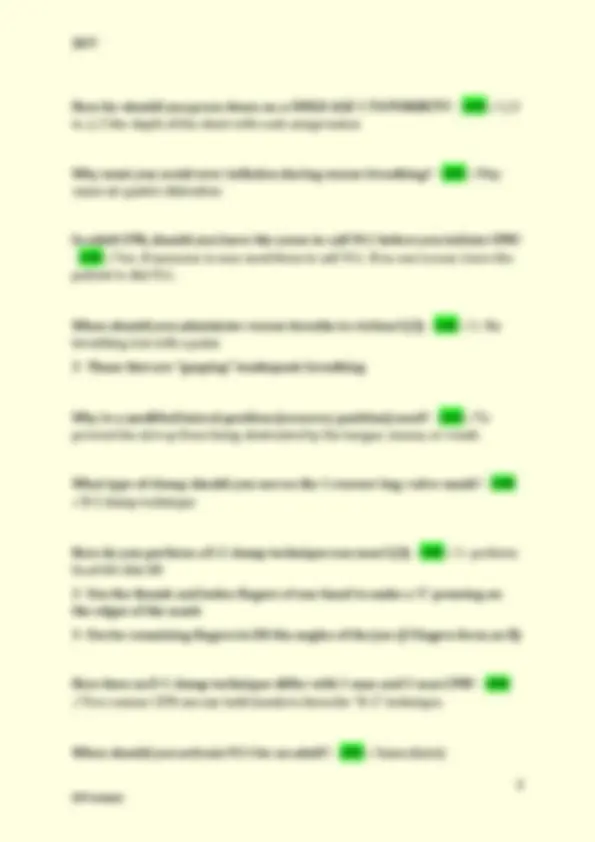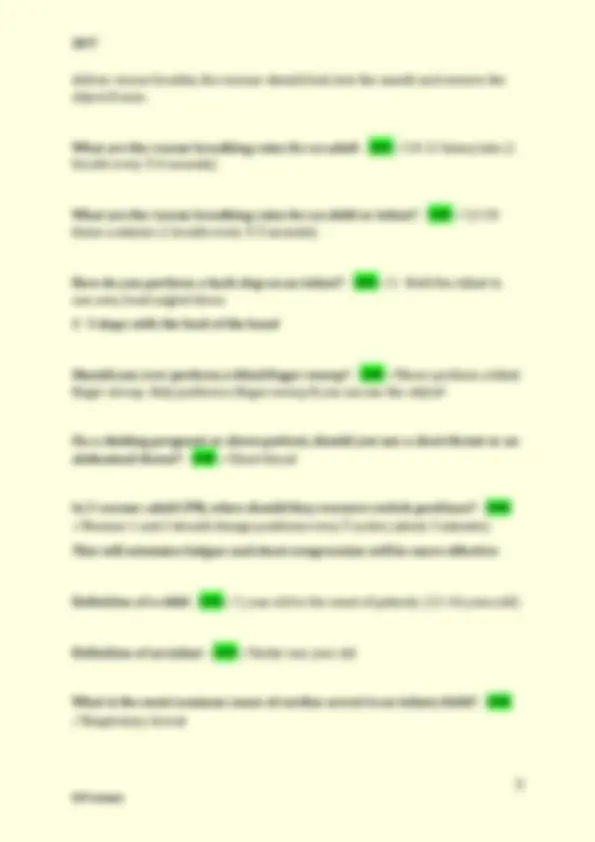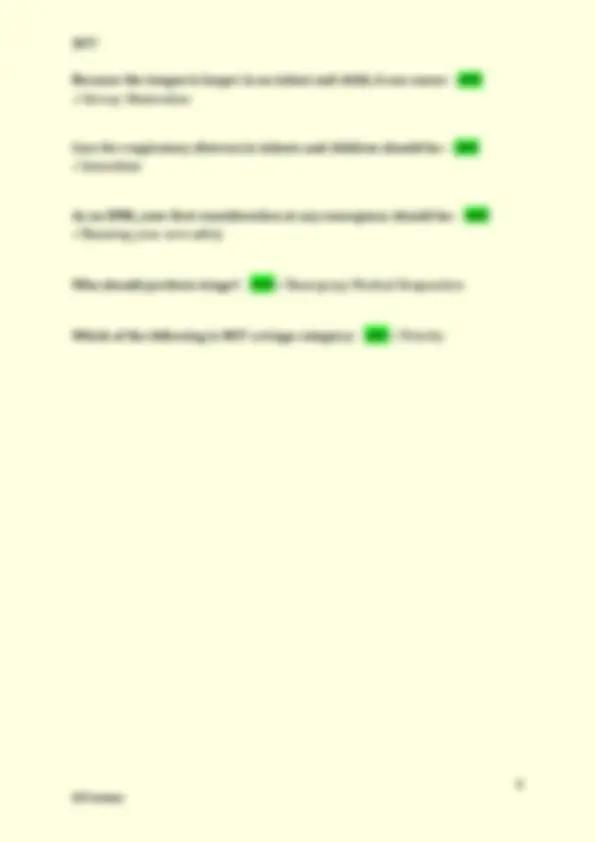







Study with the several resources on Docsity

Earn points by helping other students or get them with a premium plan


Prepare for your exams
Study with the several resources on Docsity

Earn points to download
Earn points by helping other students or get them with a premium plan
Community
Ask the community for help and clear up your study doubts
Discover the best universities in your country according to Docsity users
Free resources
Download our free guides on studying techniques, anxiety management strategies, and thesis advice from Docsity tutors
A patient with a deformity to the lower leg near the ankle, on the inside of the leg would be listed as having in injury to the _____ and ____ portion of the extremity. - ANS ✓Distal; Medial For the body to be in the anatomical position, it should be: - ANS ✓Standing, Facing the observer, and upright, hands facing forwards You placed a patient on your stretcher. His blood pressure is 90/20 and he feels light-headed. The best way to position your patients stretcher is in the: - ANS ✓Trendelenburg position, head below the heart All of the following are indicators for a non-emergency move except: - ANS ✓the patient is unconcious You are called to a house for an elderly male who fell in the bathroom and is complaining of pain to his right hip. The best type of equipment to use would be the: - ANS ✓the scoop stretcher
Typology: Exams
1 / 9

This page cannot be seen from the preview
Don't miss anything!






A patient with a deformity to the lower leg near the ankle, on the inside of the leg would be listed as having in injury to the _____ and ____ portion of the extremity. - ANS ✓Distal; Medial For the body to be in the anatomical position, it should be: - ANS ✓Standing, Facing the observer, and upright, hands facing forwards You placed a patient on your stretcher. His blood pressure is 90/20 and he feels light-headed. The best way to position your patients stretcher is in the: - ANS ✓Trendelenburg position, head below the heart All of the following are indicators for a non-emergency move except: - ANS ✓the patient is unconcious You are called to a house for an elderly male who fell in the bathroom and is complaining of pain to his right hip. The best type of equipment to use would be the: - ANS ✓the scoop stretcher After getting the angina patient downstairs and to the cot, the best position for the patient to be transported to the emergency dept is the ____ position. - ANS ✓Semi-sitting Good transfer of care contains all of the following EXCEPT: - ANS ✓make of the patients car
CPR consist of 4 main parts which are: - ANS ✓Airway, Breathing, Circulation, and Defibrillation When giving CPR to an adult, how far should you press down with each compression? - ANS ✓1 1/2 to 2 inches pressing straight down on the chest bone In an adult how many compressions should you deliver in 1 minute? - ANS ✓ 100 Why is recoil important during compressions? - ANS ✓It allows complete refilling of the heart. Incomplete recoil will reduce the blood flow created by the chest compressions. How long should take to deliver a regular breath? - ANS ✓1 second. You must deliver enough air to make the chest rise What is the compression-ventilation ratio for a one man and two man adult CPR? - ANS ✓30: What is the compression-ventilation ratio for a one man CPR on a child or infant? - ANS ✓30: What is the compression-ventilation ratio for a two man rescuer infant or child CPR? - ANS ✓15: When performing one man Adult CPR, how long should you check to the breathing of the patient - ANS ✓At least 5 seconds, no longer than 10 seconds Rescuers should try to minimize interruptions to less than ______ seconds. - ANS ✓10 seconds
When should you activate 911 for an child or infant? - ANS ✓After 5 cycles or 2 minutes of CPR Where should you check the pulse on a child or an adult? - ANS ✓carotid Where should you check the pulse on a infant? - ANS ✓Brachial When should you start CPR on a INFANT OR CHILD? - ANS ✓ 1 - if no pulse 2 - or if pulse is < What compression method should you use for an adult? - ANS ✓Heel of one hand, other hand on top. OR 1 hand for small victims What compression method should you use for a child? - ANS ✓2 fingers or 2 thumbs encircling When dealing with a conscious chocking patient what treatment/ action should you take? - ANS ✓abdominal thrusts, Heimlich How long should you continue abdominal thrusts on a choking patient? - ANS ✓Repeat until the object is expelled or victim becomes unresponsive In a conscious choking infant what action should you take? - ANS ✓5 chest thrusts and 5 back slaps. Continue until object is expelled or victim becomes unresponsive When should perform a finger sweep during choking management in a unconscious patient? - ANS ✓Every time the rescuer opens the airway to
deliver rescue breaths, the rescuer should look into the mouth and remove the object if seen. What are the rescue breathing rates for an adult - ANS ✓ 10 - 12 times/min ( breath every 5-6 seconds) What are the rescue breathing rates for an child or infant? - ANS ✓ 12 - 20 times a minute (1 breath every 3-5 seconds) How do you perform a back slap on an infant? - ANS ✓ 1 - Hold the infant in one arm, head angled down 2 - 5 slaps with the heel of the hand Should you ever perform a blind finger sweep? - ANS ✓Never perform a blind finger sweep. Only perform a finger sweep if you can see the object! On a choking pregnant or obese patient, should you use a chest thrust or an abdominal thrust? - ANS ✓Chest thrust In 2 rescuer adult CPR, when should they rescuers switch positions? - ANS ✓Rescuer 1 and 2 should change positions every 5 cycles (about 2 minutes) This will minimize fatigue and chest compression will be more effective Definition of a child - ANS ✓1 year old to the onset of puberty (12-14 years old) Definition of an infant - ANS ✓Under one year old What is the most common cause of cardiac arrest in an infant/child? - ANS ✓Respiratory Arrest
How many seconds should it take for one cycle of CPR? - ANS ✓22 seconds When Paramedics arrive on scene, you give them the patients info. This is called: - ANS ✓Transfer of care Treat a mid airway obstruction as if it were a severe airway obstruction in cases where the patient is: - ANS ✓Unable to cough forcefully For patients who have a suspected spinal injury, you should use the: - ANS ✓Jaw thrust The first priority of an Emergency Medical Responder should be: - ANS ✓Scene Safety The personal protective equipment for the EMR should include: - ANS ✓A mask, eye protection, and gloves As an EMR, when you are helping a person you should: - ANS ✓Be honest and realstic You respond to a motor vehicle crash with your crew and will have to provide care to patients from a different culture. This culture is foreign to many of your beliefs. Which of the following can you legally consider when making decisions about the care you provide. - ANS ✓The patients unique medical needs An EMR is working for a paid fire service. They are required to provide care under the : - ANS ✓Duty to act provision
Failure to provide a standard of care that leads to further harm is called: - ANS ✓Negligence A 13 year old female requests that an EMR treat her broken arm. The parents were called, but they have not arrived on the scene yet. The EMR: - ANS ✓May treat her based on implied consent You have the ethical responsibility to: - ANS ✓Be ready to perform at all times, read professional publications, and maintain your skills and knowledge What are the 4 major routes of exposure - ANS ✓inhalation, absorption, ingestion, and injection. The governmental organization that sets strict standards to reduce the possibility of infectious exposure in the workplace is: - ANS ✓OSHA As an EMR, you are more at risk of contracting: - ANS ✓Hepatitis B or C Organisms that are capable of causing infections are called: - ANS ✓pathogens In medical terminology, the root for electrocardiogram is: - ANS ✓cardio You have a call for a 47 - year- old patient with abdominal paid. She points to the upper right side of her abdomen. You report the region of the patents pain as the: - ANS ✓Right Upper Quadrant (RUQ) In infants and children, the head is ____ and ____ in proportion to the rest of the body. - ANS ✓Larger; Heavier